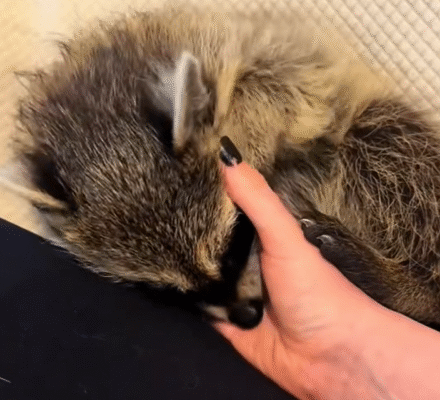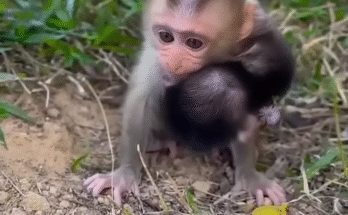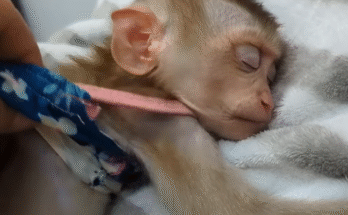
It was a quiet Thursday evening when I heard the faintest of squeaks coming from the woods behind my house. At first, I thought it was just birds settling in for the night or maybe a squirrel chattering, but something about the sound felt different—more desperate. Curious and slightly concerned, I grabbed a flashlight and headed toward the source of the noise.
The forest was dense and dark, with thick underbrush and tangled branches. I had walked that trail many times before, but this time, something pulled me in deeper. The squeaking grew louder as I stepped over roots and ducked under low branches, and soon I spotted a small bundle of fur lying near a fallen tree. My heart skipped a beat when I saw it—it was a baby raccoon.
It looked no more than a few weeks old, eyes open but glazed with confusion and fear. It was soaked from the morning rain and trembling from cold and exhaustion. I glanced around, hoping to see its mother nearby. But the forest was still and silent. No rustling, no movement—just the baby raccoon, alone and crying.
I hesitated. Wild animals should stay in the wild, I knew that much. But leaving this tiny creature there felt wrong. Predators roamed those woods at night—foxes, coyotes, even large birds of prey. If I walked away, I might be signing its death sentence. So, I wrapped the baby raccoon in my jacket and gently carried it back home.
At home, I placed it in a cardboard box lined with an old towel and set the box near a space heater to help it warm up. Its small body shivered, but after a few minutes, it let out a sigh and curled up slightly. I sat beside the box for hours, watching it sleep, occasionally googling what to feed orphaned raccoons and how to care for them properly.
I learned that baby raccoons require a special formula—kitten milk replacement (KMR) mixed with a bit of water. Luckily, the local pet store carried it, so I rushed over the next morning and picked up supplies. Using a small syringe, I offered the baby a few drops at a time. At first, it resisted, but hunger eventually won, and it started to feed.
I named him Bandit. It seemed fitting, with his dark mask-like markings and clever little paws. Over the next few days, Bandit became stronger. His eyes were brighter, and his cries more confident. He started exploring the corners of the box and, eventually, my living room. I built him a small enclosure with soft blankets, a stuffed toy for comfort, and a little perch from an old cat tree.
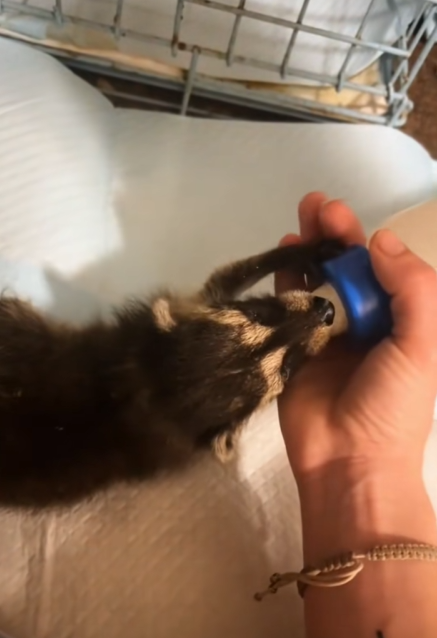
Caring for Bandit was no easy task. He needed feeding every three to four hours, and he was incredibly curious—constantly climbing, chewing, and knocking things over. But he was also gentle and oddly affectionate. He’d fall asleep in my lap or curl up on my shoulder, his tiny claws clinging gently to my shirt.
I contacted a local wildlife rehabilitation center for advice. They were surprised to hear my story and told me they had received multiple calls about raccoons being orphaned due to increased construction in nearby areas. The center offered to take Bandit in, but they also encouraged me to continue caring for him if I was willing—until he was old enough to be released into the wild.
That was my plan from the start: to raise him until he was ready, not keep him as a pet. Bandit was a wild animal, and he deserved to live in his natural habitat, not a living room. So, I began to prepare for that eventual day. I made sure he had plenty of time outside in a secure enclosure to get used to the sights and smells of nature. I offered him wild foods—berries, nuts, insects—to help him learn what to forage.
As he grew, Bandit became more independent. He still came to me for food and comfort, but I could tell he was developing that wild spirit that raccoons are known for. He’d climb trees with remarkable speed, dig through the dirt for bugs, and even try catching frogs by the pond. Watching him reminded me that I was only a temporary guardian—a bridge between helplessness and freedom.
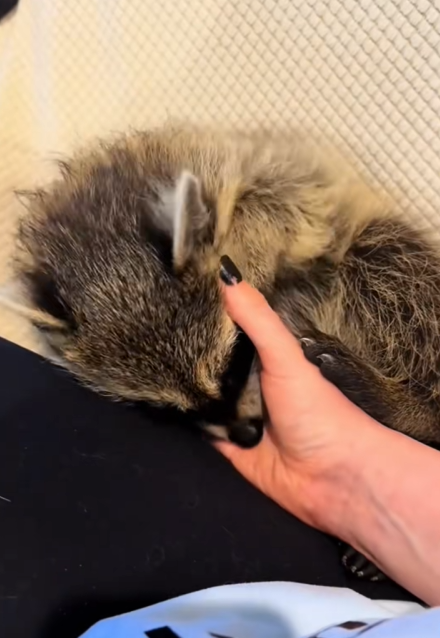
The hardest part came six weeks later when it was time to let him go. The wildlife center staff helped me assess whether he was ready. He had passed every test—feeding on his own, avoiding human contact (except with me), and responding to natural sounds and dangers appropriately. So, on a crisp morning in early autumn, I took him back to the forest, to a protected area the center monitored for released animals.
I opened the carrier, and Bandit hesitated for just a moment. He looked at me, his eyes filled with something I couldn’t quite describe—gratitude, maybe, or curiosity. Then, with one final squeak, he scurried off into the underbrush and disappeared.
I sat on a nearby rock for a long time, listening. The forest was quiet again. But it wasn’t the lonely silence I had heard the night I found him. It was peaceful, natural—a reminder that Bandit was where he belonged.
I still think about him sometimes, especially when I walk the trail behind my house. I like to imagine him thriving out there, a grown raccoon with a family of his own, showing his kits how to climb, forage, and survive. Maybe he even remembers me in some instinctive way—the strange human who gave him warmth, food, and a second chance.
Rescuing Bandit taught me more than I expected. It reminded me of how fragile life can be and how a small act of kindness can change everything. It made me appreciate the balance between nature and nurture, and how sometimes, the right thing to do is simply to care.
Would I do it again? In a heartbeat. Because sometimes, in the middle of an ordinary day, you get the chance to be a hero for a creature that can’t thank you with words—but shows you in every small way that it mattered.
